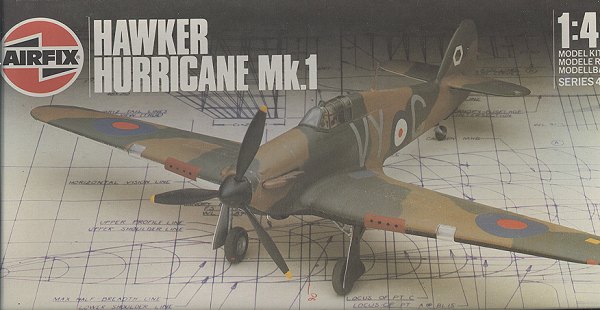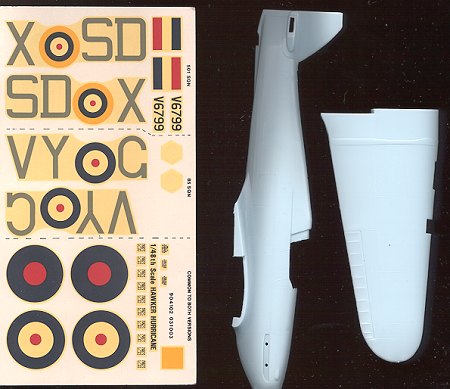
|
KIT: |
Airfix 1/48 Hurricane I |
|
KIT # |
4102 |
|
PRICE: |
$11.00 |
|
DECALS: |
Two units: 85 and 501 Squadrons, RAF |
|
REVIEW & |
|
|
NOTES: |
|

|
HISTORY |
When one thinks of the Battle of Britain, one generally thinks of Spitfires and Bf-109s. However, it was the Hawker Hurricane that was the most numerous fighter aircraft of that time period. It was the aircraft that was sent in to attack the German Bombers while the Spitfires would do battle with their escorts. Fighter Command's only winner of the Victoria Cross, the British equivalent of the Medal of Honor, went to a Hurricane pilot, Lt J.B. Nicholson of 249 Sq, during the Battle of Britain.
The Hurricane I, was a simple tube framed aircraft covered with metal on the front part of the fuselage, and fabric on the rear section. All the control surfaces were fabric as was most of the wing on the very early Hurricane I. This fabric wing was later replaced by a stressed metal skin in early 1939, the first aircraft with them being L 1877. Initial Hurricane Is also had a two bladed wooden propeller, this being replaced by a deHavilland three bladed metal prop starting with L 1562, which flew in mid-1938. Starting in October 1939, the deHavilland propeller was replaced with a wider chord version from Rotol. This new propeller greatly improved the climbing ability of the Hurricane, enabling it to reach attacking bombers much sooner than with the older propellers.
There are many reasons the Hurricane was such a huge success during the Battle of Britain. First of all, it could be produced quickly. Because of its ease of construction, Hawker was able to exceed its production quotas, month after month. In fact, during the early war years, 7 of 10 fighter aircraft produced were Hurricanes. It was also more maneuverable, a more steady gun platform, able to withstand more damage, and easier to fly than the Spitfire. Because of these attributes all the newly created squadrons during the Battle were Hurricane squadrons. It was also easier to repair. Another plus was its wide track undercarriage that made landing and ground operations much easier than the narrow tracked Spitfire.
|
THE KIT |
 Airfix's
kit of the Hurricane I is still the only one of the early mark that is readily
available in 1/48. Despite it's age (my boxing is dated 1982), the kit holds up
quite well to the newer releases from Hasegawa.
Airfix's
kit of the Hurricane I is still the only one of the early mark that is readily
available in 1/48. Despite it's age (my boxing is dated 1982), the kit holds up
quite well to the newer releases from Hasegawa.
OK, so what's in the box? Once by the rather bland box art, one is confronted by a sea of light blue plastic. Not sure who it was that came up with these colors but it is distinctive! The detailing is of the raised panel line variety with engraved control surfaces. The fabric effect is rather subdued in relation to the newer kits from Hasegawa and is more like what one sees in photographs of the Hurricane.
My kit was relatively flash free, only showing a bit of flash on some of the smaller parts. There were, however a number of sink marks on the fuselage, those corresponding with the thicker plastic around the alignment pins. There were some very deep ones on the main gear well insert, but those will be out of sight on the completed kit. One is given the option of both the Rotol and deHavilland propeller and spinner, so it is important that you choose the right one for the aircraft you are modeling.
The canopy is a one-piece affair, so any desire to show the cockpit will necessitate either cutting the kit canopy or purchasing an aftermarket vac one. Detail in the cockpit is not bad for the time. There is some sidewall detail as well as some detail on the instrument panel, but it is rather basic and not up to today's standards. The interior is made of a seat, floor, rear bulkhead, control stick, seat, instrument panel and gunsight. There are no rudder pedals, though a pilot is included should you wish to add him. Though a bit thick, the transparency is clear enough to see any detail you put inside.
Decals are for two aircraft. One is from 85 squadron operating in France in early 1940. The other is from 501 squadron during the Battle of Britain. My decal sheet is unusable thanks to its age and the yellowing of the carrier film, but this isn't a problem as there are a multitude of available aftermarket sheets for this aircraft.
The instructions are the usual set of drawings, giving 14 steps and showing each part. There are color callouts in the various steps, each giving Humbrol paint numbers. In addition there is a paint chart showing what color each of the paint numbers relates to.
Overall, it appears to be a very nice kit, despite its age. Looking in the latest Squadron catalogue, it retails for about 35% of the asking price for the Hasegawa kit, making it a good choice for the modeler who wants a good kit and doesn't have the extra funds to spend.
Review copy courtesy of me and my wallet!
If you would like your product reviewed fairly and quickly by a site that has over 800 visits a day, please contact me or see other details in the Note to Contributors.